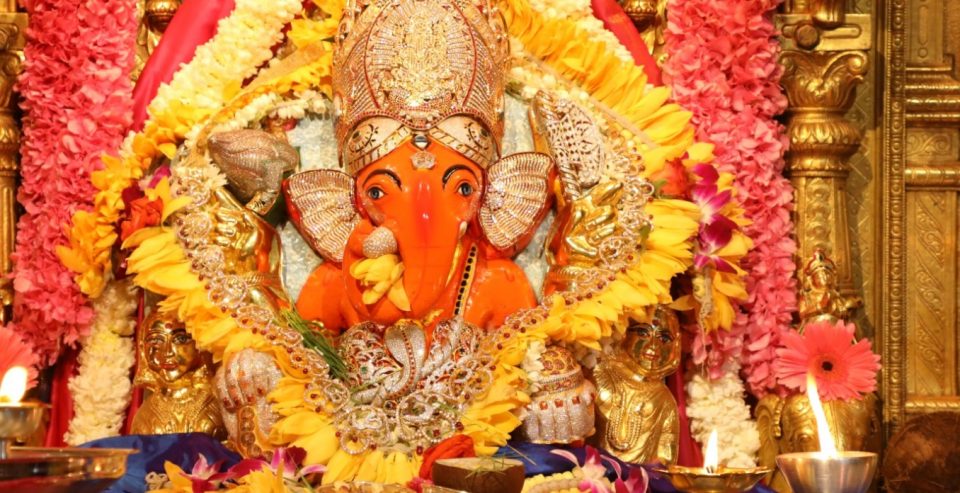
The Ganesha at Siddhivinayak and the tale of the trunk’s tilt

Today marks the completion of 220 years since a Ganesha idol was consecrated at Mumbai’s famous Siddhivinayak Temple located in Prabhadevi. Back then, the temple was a small structure housing Shree Siddhivinayak’s black stone idol, two-and-a-half feet wide.
With over 70,000 visitors every day now, many do not get enough time to take a good long look at the idol and notice the tilt of Ganesha’s trunk.
“The outstanding feature of this deity is the tilt of the trunk to the right side,” says the temple’s website.
The idol has four hands (Chaturbhuj), holding a lotus in the upper right, a small axe in the upper left, beads in the lower right, and a bowl full of modaks (a delicacy mythlogically considered to be a favourite with Ganesha).
Flanking the deity on both sides are Riddhi and Siddhi, his two wives. Etched on the forehead of the deity is an eye, which resembles the third eye of Lord Shiva.
The trunk’s tilt assumes importance for its rarity.
Left versus right
The marital status of Lord Ganesha varies from one mythological story to the other. In the south, he is considered a bachelor with no wives to distract him. In Bengal, he is married to ‘kaula bou’, a symbolic wife made out of the leaves of a banana plant. Another story states that Ganesha found it difficult to get married because of his elephant head, and therefore created trouble in the marriage ceremonies of other celestial deities.
Legend has it that the Gods ended up asking help from Brahma, the universal creator, who then created Riddhi and Siddhi and gave them in marriage to Ganesha.
Riddhi, who sits on Ganesha’s left, represents wealth and prosperity in Hindu mythology, whereas Siddhi, who sits on his right, represents higher spiritual powers as well as intellect. While majority of Ganesha idols—especially those brought home during the festival of Ganeshotsav—have their trunk facing the left, the Siddhi Ganesha has its trunk facing the right.
The direction of his trunk is indicative of what is desired by the individual praying to Ganesha – wealth or moksha.
Prasad Khandekar, who is employed at the temple as a guruji, says: “The right-side facing trunk of Ganesha is called Siddhi and the Ganesha where the trunk is facing left is called Ganapati. Actually, Ganapati and Siddhi are two different entities. Both are forms of Ganesha—but have different characteristics.”
“Those people who are on the path to sadhana…the Siddhi Ganesha with its trunk facing to the right, is meant for them. This type of Ganesha requires special worship.”
The Siddhi Ganesha is not commonly found at people’s homes owing to the strict religious compliance that one needs to follow while praying to this idol.
Khandekar, however, has a different take on Riddhi and Siddhi.
“It is a common misconception that Riddhi and Siddhi are Lord Ganesha’s wives—they are actually his dasis (slaves),” says Khandekar.
Mumbai-based sculptor and artist Rintu Rathod, an ardent Ganesha devotee who is credited with inventing the concept of an environment-friendly ‘Chocolate Ganesha’ almost a decade ago, has, over the years, conducted numerous workshops wherein she teaches her students how to make Ganesha idols out of chocolate, kheer, and other consumable food items.
In all these years, there have only been a few occasions wherein a few specific students asked her to teach them how to make a Ganesha idol with its trunk facing to the right.
Rathod has, however, made a few Siddhi idols over the years for her home as well as for others. “I always teach all aspects related to Ganpatiji and the significance of each and every element of the idol to my students,” she said. “Some of them come with a specific request to make the idol with a right-side facing trunk. For me, the process of making both types of idols is the same. I make each and every idol by adhering to proper rituals, whether with the right side trunk or left side.”
“As per belief, the right-sided trunk Ganesha is more powerful,” she said.
“The right-sided idols are found only in temples and left-sided ones at homes since people with families have duties and cannot let go of pleasures. Due to all these bondages, they cannot worshipping the Siddhi form of Lord Ganesha.”
Asked why people commonly not to keep a Siddhi Ganesha at home, she said: “People are scared as it is a popular belief that if you cannot worship the Siddhi Ganesha properly, then it will harm you…and obviously nobody wants anything bad happens to them….”
Rathod says she had kept a Siddhi Ganesha at home herself. “Personally for me, the Ganapati murti is symbolic. the most important thing is to make a connection with the supreme energy, and my treatment for both kinds of idols is always the same. I pray to both kinds of idols fervently, earnestly, and honestly. Rituals become secondary for me.”
Pankaj Joshi, a guruji by profession who has done his MA in Vedic Studies, compares the Siddhi Ganesha with Jyoti Lingams. “There are thousands of shiv lings that can be found across the world—but the few Jyoti Lings like the ones at Somnath and Kedarnath—are special in their own right. The same is for the Siddhi Ganesha, whose trunk faces to the right. These types of Ganesha idols have a special place and power of their own.”
He says that when one sets an intention based on his prayer, it is Riddhi, whereas, upon completion of the desired intent, he has achieved Siddhi. “We need to go through the path of Riddhi and Ganesha to finally reach Siddhi. It is a process. You start your journey from Riddhi, but as you achieve your destination…it becomes Siddhi. The Siddhi Ganesha is not common in people’s homes because one cannot reach Siddhi directly—they have to go through Riddhi first.”


